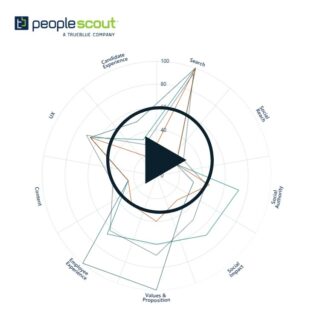Data analytics is a valuable tool for talent acquisition professionals, as specific data can be used to predict things like the success of a candidate or the time it will take to fill a position. It can also help build the type of candidate-centered hiring experience that’s necessary to stay competitive in this tight talent market.
However, sophisticated artificial intelligence and massive sets of data can make data analytics seem overwhelming and confusing. In order to understand what this technology can do, you need to have a basic understanding of what goes into the process. We’ve put together some definitions for the terms you need to know to start to take advantage of data analytics in your organization.
Big Data:
Big data is a simple sounding term, but experts say defining it can be surprisingly complicated. Forbes argues there could be as many as 12 different ways to interpret the phrase. Some of these explanations are practical like, “data of a very large size, typically to the extent that its manipulation and management present significant logistical challenges.” Other definitions focus on the forces that drive the use of these large data sets like, “a new attitude by businesses, non-profits, government agencies, and individuals that combining data from multiple sources could lead to better decisions.”
When we’re talking about how data can be used in recruiting, think about big data as the raw material, the large sets of information, that can be used to make predictions and inferences about candidates, employees and staffing needs.
Small Data:
Data doesn’t have to be big to be useful. For many organizations, smaller sets of internal data can provide critical insights. According to the Harvard Business Review, small data is data of a manageable size that is already somewhat organized, and it mostly comes from your own data systems. Most organizations have been using small data for years.
Data Analytics:
Big data and small data are useless unless you have a way to analyze it; that’s where data analytics comes in. An article in the International Journal of Information Management calls data analytics the “efficient processes to turn high volumes of fast-moving and diverse data into meaningful insights.” There are a few types of data analytics – descriptive, predictive and prescriptive.
Descriptive Analytics:
Descriptive analytics describe what happened in the past. Descriptive analytics software combs through large or small data sets and produces useful information about trends and patterns. According to Information Week, the purpose of descriptive analytics is simply to summarize what happened.
Predictive Analytics:
Predictive analytics is the next step. It uses data to find patterns and then uses those models to attempt to predict the future. Predictive analytics can’t tell you what will happen, but it shows what is likely to happen based on past trends.
Another way to look at it, according to PC Magazine, is that predictive analytics is something you can do with AI, machine learning and deep learning. Predictive analytics takes large sets of data and then applies these different forms of technology to see trends and patterns that would be difficult, time-consuming or possibly impossible for humans to accomplish alone.
Prescriptive Analytics:
Prescriptive analytics is a type of predictive analytics that goes a step further. Rather than just predicting what could happen in the future, prescriptive analytics goes so far as to recommend one or more courses of action, as well as the likely outcomes of those decisions, according to Information Week.
Not only can prescriptive analytics predict what is likely to happen, it can also predict the best course of action for a person to take to get a particular outcome. Think about prescriptive analytics as predictive analytics with the ability to make a decision.
AI, Machine Learning and Deep Learning:
Artificial intelligence is an umbrella term. Put most simply, it is a branch of computer science that involves computers doing things normally done by people.
We use AI to perform data analysis because having humans process and analyze all the information would be overwhelming, time-consuming, expensive and in most cases, nearly impossible.
Machine learning and deep learning are the next steps in artificial intelligence, where computers are able to learn how to do something without being specifically programmed how to do that one thing. Machine learning develops algorithms, which are procedures or processes for solving problems. Deep learning is a type of AI that mimics the way the human brain works.
This is especially important to predictive and prescriptive analytics, where the goal is to look beyond what happened in the past and find ways to apply it to what might happen in the future.
What Can Data Analytics Do?
Data analytics technology has applications throughout the entire sourcing and recruiting process. The ability to make predictions and suggest a certain course of action can give employers a better understanding of factors like how long it will take to fill a position or what kind of salary and benefits package will be required to secure a successful candidate. When it comes to candidate success, predictive analytics can use candidate assessments to predict how successful a person will be in a given role and even how long they may stay with the company. Armed with that information, organizations can make better hiring decisions.
If you’re in the business of working with people, at first, data analytics can seem cold, but when applied correctly, it can actually make the hiring process more personal. Candidates leave data behind whenever they go online, log in to a social media profile or make Google search. Marketers are already tapping into that information to personalize and target content. Talent acquisition professionals can make that same data work to customize the sourcing and recruiting process.
We’ll have more on what data analytics can do for the industry and what issues to watch for on the blog in the coming weeks. To learn more about AI, machine learning and deep learning, read our blog post about what they mean to recruiting.
Data analytics is one of the top seven tech trends impacting the talent acquisition industry. To learn more about some of the possible impacts and the six other trends, download our ebook: Seven Tech Trends Shaping the Talent Landscape.



